If you’re looking for help to identify birds with long beaks in Florida, this will be the best article you read today.
In this post, you will find photos, identification info, bill size comparison, and all the fun information you need.
Examples of Florida birds with long beaks include the black skimmer, limpkin, American woodcock, great egret, great blue heron, American flamingo, brown pelican, and many others.
The bird with the longest beak in Florida is the American white pelican with a beak that can be over 15 inches long!
Here are the 20 most interesting ones.
Table of Contents
Florida Birds With Long Beaks
Ruby-throated Hummingbird
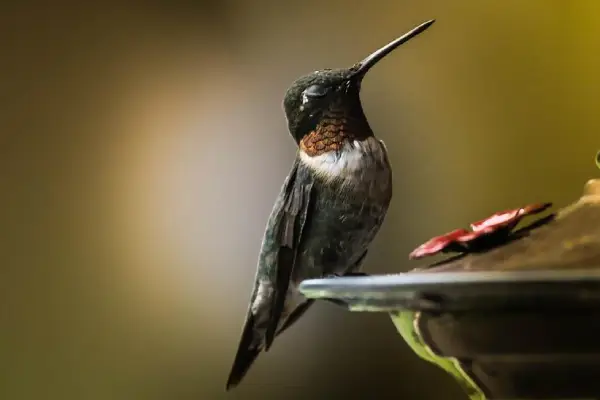
- Scientific Name: Archilochus colubris
- Lifespan: 3-5 years
- Beak Length: 0.59-0.79 in
- Body Length: 2.8-3.5 in
- Range In Florida: Southern, Central, and Northern Florida
These tiny green birds are one of the smallest and most common hummingbirds found in Florida.
The species is sexually dimorphic: males have metallic emerald green upperparts, grayish-white underparts, black wings, and a gorget (throat patch) of iridescent ruby red. Their tails are forked.
Females are larger than males and have white throats.
Despite having a body length of 2.8-3.5 in, ruby-throated hummingbirds have very long and narrow beaks that are perfect for sipping nectar from deep inside flowers.
Their bills are black and straight and take almost ¼ of their entire body!
These beautiful birds with brilliant orange-red throats can be seen in the central and northern parts of Florida throughout the year. During winter, they might also inhabit the southern coastal parts of the state.
Ruby-throated hummingbirds move very quickly, around 25 mph, and will beat their wing over 50 times per second.
These birds are mostly solitary, except during the breeding season which lasts a few days.
To attract these incredible birds with red necks to your backyard, you can set up hummingbird feeders or plant tubular flowers. They are quite bold and might even feed at hanging plants and feeders on your porch or next to your windows!
Belted Kingfisher
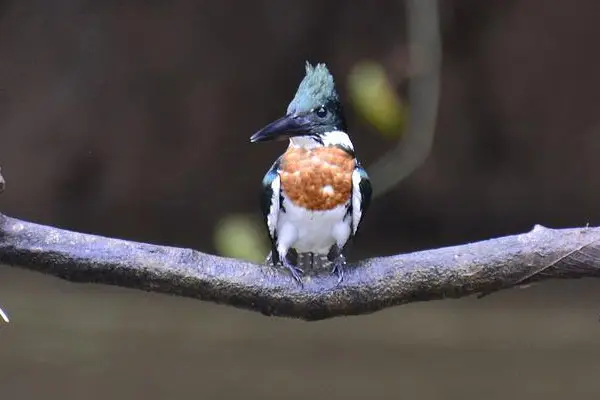
- Scientific Name: Megaceryle alcyon
- Lifespan: 6-14 years
- Beak Length: 2 in
- Body Length: 11-14 in
- Range In Florida: Throughout Florida
Belted kingfishers are a very large species of water kingfishers that have large heads and shaggy crests on top.
Males are slate blue with white underparts, while the females have orange patches on their bellies and flanks and are a lot brighter than males – brighter female plumage is not very common among birds.
Belted kingfishers have very long and heavy black beaks with gray bases. Their beaks are around 2 inches long and shaped like daggers; kingfishers use them to catch fish and crayfish.
Belted kingfishers are permanent residents of Central and Northern Florida and breed there from April to July. Some populations will migrate to southern parts of the state to winter there.
The alarm calls of belted kingfishers are harsh mechanical rattles and occasionally screams.
Source: Jonathon Jongsma, CC BY-SA 3.0, via Wikimedia Commons
They also have two fused toes which can also help distinguish these blue-winged birds from others.
When the breeding season comes, they become very territorial – males will often charge at and chase intruders away.
Belted kingfishers are carnivores that dive to catch fish and crayfish with their heavy beaks; they also feed on mollusks, crustaceans, amphibians, and lizards.
They can’t digest bones, so just like owls, they regurgitate the undigested pieces as pellets.
Besides Florida, they are just one of many birds seen in Pennsylvania, Maryland, North Texas, Western Washington, and Southern California.
Black Skimmer
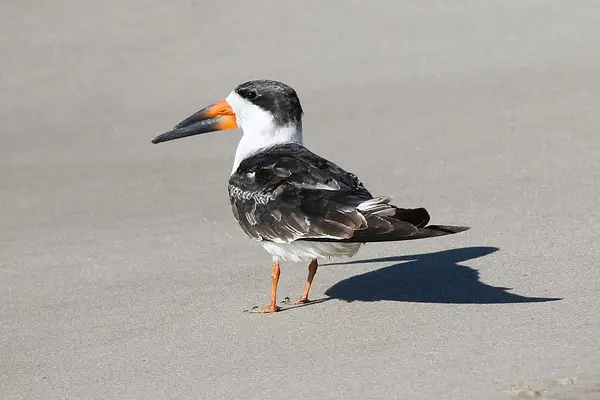
- Scientific Name: Rynchops-niger
- Lifespan: up to 20 years
- Beak Length: 2-2.5 in
- Body Length: 16-20 in
- Range In Florida: Coastal parts of Florida
Black skimmers are unique seabirds that are black above, white below, and have dark brown eyes, and red legs. During the non-breeding season, they become browner.
They are the largest of the three skimmer species and can measure up to 1 ft 8 inches in length.
Black skimmers have large red and black beaks. Their beaks are wide at the top and become smaller towards the tip. The lower mandible is longer than the upper, making it easier for skimmers to skim along the water surface and catch fish.
Black skimmers are permanent residents of Florida, commonly found around its estuaries, beaches, and sandbars. Identify them by their barking “kak-kak” calls.
They are social birds that breed in the state between May and September, nesting in colonies with up to several hundred pairs. Both parents will incubate their 3-5 eggs.
Black skimmers are carnivores that feed on small fish, insects, crustaceans, and mollusks.
King Rail
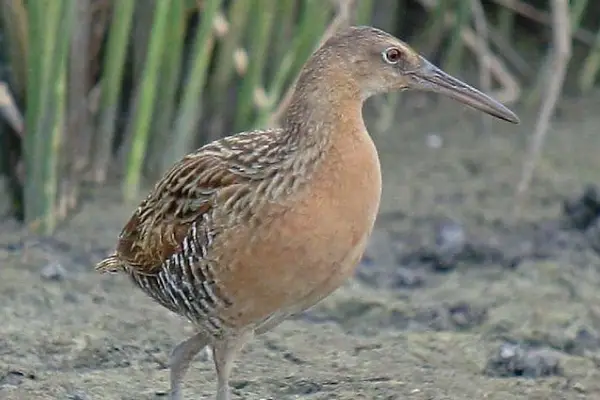
- Scientific Name: Rallus elegans
- Lifespan: 5-9 years
- Beak Length: 2.3–2.6 in
- Body Length: 15.5-19 in
- Range In Florida: Throughout Florida
King rails are the largest rail species in North America. They are the size of a chicken and have small heads, fairly long necks, short tails, and long legs.
Adults have brown backs and rusty brown faces and breasts; on top of their heads, there are dark brown caps.
King rails have very long and slightly curved orange-brown beaks measuring around 2.3-2.6 inches in length that they use to find food.
They are permanent residents of Florida’s freshwater marshes and can be seen there throughout the year.
King rails have low repeated grunt calls that sound like “kek-kek-kek.”
They forage by probing the mud with their long brakes, looking for aquatic insects and crustaceans.
Scientists once recorded a male catching 7 crayfish in 2 hours and offering 5 of those to his partner during courtship.
Because of the habitat loss, king rails’ numbers have declined by 90% in the last 50 years.
American Avocet
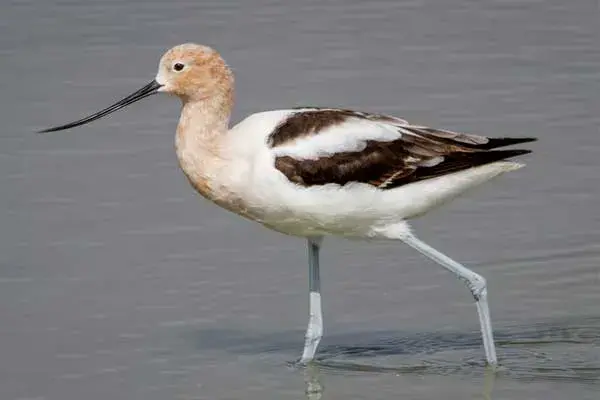
- Scientific Name: Recurvirostra americana
- Lifespan: up to 9 years
- Beak Length: n/a
- Body Length: 16-21 in
- Range In Florida: Coastal parts of Florida
American avocets are large and slender shorebirds, commonly found around shorelines, mudflats, and ponds.
They can be identified by their buffy heads and necks and bluish-gray legs; they are black above, white below, and have black wings with large white wing patches.
American avocets have long, black, pointed beaks that are slightly upcurved towards the tips. The exact beak measurement is unknown, but it’s almost twice the length of their tiny rounded heads.
American avocets can be seen in coastal parts of Florida during winter; they migrate in huge flocks of 30-500 birds to breed in marshes, beaches, prairie ponds, and shallow lakes of central and western USA and parts of Canada.
They can also be identified by their repeated, high-pitched “kleet” calls.
Source: Jonathon Jongsma, CC BY-SA 3.0, via Wikimedia Commons
To catch aquatic insects, avocets will put their beaks underwater and move them side to side to stir the water and drive them out.
These Florida birds with long beaks are omnivores and mainly consume fish, aquatic insects, seeds, and crustaceans.
American avocets are monogamous and both parents take care of the young.
Limpkin

- Scientific Name: Aramus guarauna
- Lifespan: n/a
- Beak Length: n/a
- Body Length: 25-29 in
- Range In Florida: Southern and Central Florida
Limpkins are large wading birds with heavy bodies and large necks, weighing almost 3 pounds.
Males are larger than females, but both sexes look alike. They are mostly brown and have white spots and streaks that are densest on their heads and necks.
Limpkins have long, heavy, yellowish beaks with darker tips that are curved downwards. Their beaks are slightly open closer to the mouth but closed at the tip, similar to tweezers.
The beaks in some individuals might be curved a bit to the right, making it easier to slip into the right-curved shells of apple snails.
Limpkins are permanent residents of Florida and can be seen around freshwater marshes and swamps; they nest in the state from February to June.
They can be identified by their loud screaming “klaaar” calls, clucks, piercing “bihks,” etc.
Source: Niels Krabbe, CC BY-SA 4.0, via Wikimedia Commons
Limpkins love to forage in shallow waters, and besides their favorite apple snails, they might also consume some insects, frogs, lizards, worms, and seeds.
Some individuals are monogamous for a season or two. Both partners will take turns in incubating the clutch of 3-8 eggs.
Limpkins were named after their slow gait that resembles limping.
Great black-backed Gull

- Scientific Name: Larus marinus
- Lifespan: up to 27 years
- Beak Length: 2.1-2.85 in
- Body Length: 25-31 in
- Range In Florida: Southeastern Florida
Great black-backed gulls are the largest gulls in Florida with a wingspan of up to 5 ft 7 inches and a weight of over 5 pounds. They have white heads, necks and underparts, dark grey wings and backs, and pink legs.
Great black-backed gulls have large and powerful beaks that range from 2.1 to 2.85 inches in length. Their beaks are yellow or yellow-pink and have some red or orange patches on the lower mandible.
Great black-backed gulls can be seen during winter in Southeastern Florida, along the Atlantic coast.
They have a deeper voice than other gulls, and will often make deep “laughing” “kaa-ga-ga” calls.
Source: Tony Phillips, CC BY-SA 3.0, via Wikimedia Commons
Often described as “kings of the Atlantic waterfront”, great black-backed gulls are very aggressive hunters, pirates, and scavengers.
Because of their enormous size and omnivorous feeding habits, these birds will prey on other birds during the nesting season.
Great black-backed gulls also feed on carrion, fish, mollusks, crustaceans, marine worms, insects, rodents, and berries.
Great black-backed gulls were hunted for their feathers that were used to make hats. As a result, this species got eradicated from large parts of its range.
Today, however, due to their improved adaptability to humans, their populations have increased in numbers. In fact, they became so widespread that in some areas people now consider them pests.
American Woodcock

- Scientific Name: Scolopax minor
- Lifespan: 2 years
- Beak Length: 2.5-2.75 in
- Body Length: 10-12 in
- Range In Florida: Throughout Florida
American woodcocks are small shorebirds found in eastern parts of North America. They mainly inhabit brushy and young-forested habitats and are easy to spot by their large heads, short necks, and short tails. Their plumage is a mix of browns, grays, and blacks.
American woodcocks have very long, straight, and prehensile beaks they probe the soil with in pursuit of food. Thanks to the unique bill structure, woodcocks can open and close the tips of their upper bills while they are sunk in the ground.
The inside of the upper bill and the tongue have rough surfaces to make slippery prey grabbing easier. Females have slightly longer beaks than males.
American woodcocks are permanent residents of central and northern Florida; in southern parts of the state, these long-beaked birds stay only during winter.
They are also known as timberdoodles, bogsuckers, and hokumpokes and have unique and large eyes that allow them to see 360° horizontally and 180° vertically.
American woodcocks are popular game birds, with over half a million birds caught annually by hunters.
These birds are most active at night, and at dawn and dusk (a characteristic of crepuscular animals).
American Oystercatcher
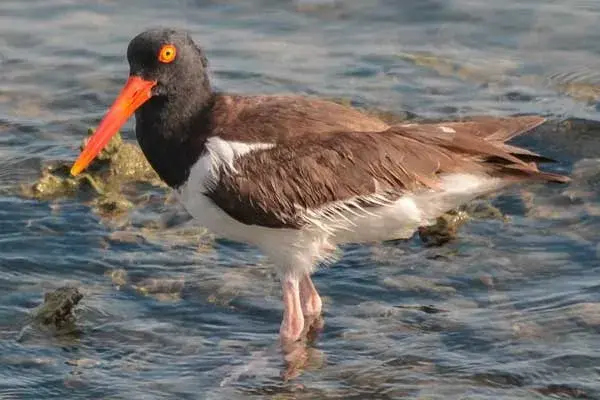
- Scientific Name: Haematopus palliatus
- Lifespan: 10-14 years
- Beak Length: 2.8-3.1 in
- Body Length: 17-20 in
- Range In Florida: Southern Florida and Florida Panhandle
American oystercatchers are large shorebirds found on the beaches of the Atlantic and Gulf coasts. They have black heads and breasts, grayish-brown backs, tails, and wings, and white underparts. Their yellow eyes are edged with orange eye-rings.
American oystercatchers have long, bright orange beaks, around 3 inches long. The beaks are razor-sharp and the birds use them to pry open oysters and other bivalves for food, hence the name “oystercatcher”.
American oystercatchers are permanent residents of the shores of the Florida Panhandle and breed there from April to July; some populations might migrate to southern parts of the state during winter.
During the breeding season, they inhabit sand or shell beaches, dunes, salt marshes, marsh islands, and mudflats; when the winter comes, they are common around shellfish beaches and mud and salt flats.
Oystercatchers are social birds often seen during the day foraging, preening, resting, and sunbathing.
Anhinga

- Scientific Name: Anhinga anhinga
- Lifespan: 12 years
- Beak Length: 3.2 in
- Body Length: 30-37 in
- Range In Florida: Throughout Florida
Anhingas are large and slender waterbirds that are also known as snakebirds, darters, or water turkeys.
Male anhingas have black plumage with white spots on their wings and back while the females look similar but have brownish necks and heads.
Only their long necks appear above water when they swim, making them look like snakes, hence the nickname snakebird.
Anhingas have long yellow beaks that are sharply pointed, almost like daggers. The beaks are around 3.2 inches long and are used for hunting and spearing fish.
Anhingas are permanent residents of Florida and can be seen throughout the state year-round. They inhabit lakes, freshwater marshes, ponds, and canals.
Anhingas have loud clicking calls that resemble sewing machines or croaking frogs.
Source: National Park Service, Public domain, via Wikimedia Commons
The name anhinga comes from the Brazilian Tupi language and means “devil bird” or “snake bird”.
Anhingas do not have waterproof wings as other birds do and can be often seen drying their feathers in the sun.
Anhingas are carnivores that feed on fish, insects, shrimp, crayfish, and sometimes even young alligators and snakes.
Great Egret
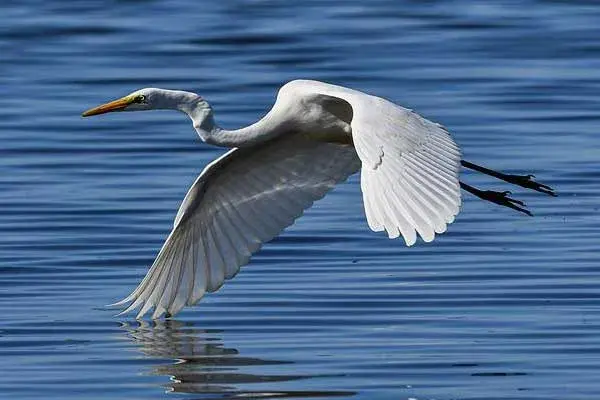
- Scientific Name: Ardea alba
- Lifespan: 22 years
- Beak Length: 4.2-5.3 in
- Body Length: 31-41 in
- Range In Florida: Throughout Florida
Great egrets are impressively large birds with long necks and a wingspan of up to 5 ft 7 in. They have all-white plumage and long black legs.
Great egrets have long yellow-orange beaks that are between 4.2 and 5.3 inches long; they use them for hunting. During the breeding season, their beaks might become darker.
Great egrets are permanent residents of Florida and can be seen there throughout the year, around wetlands and other areas of water. Breeding might happen in any part of the year, but it’s most common from May to August.
Their beautiful plumes called “aigrettes” were used as hat decoration in the 19th century which led to them almost becoming extinct. Thanks to several laws and conservational measures, their numbers have since recovered.
Similar to pelicans because of their white plumage, great egrets can also tuck their necks right into their backs during flight.
They are seasonally monogamous (stay with the same partner for one breeding season) and breed in colonies in trees close to large lakes.
To attract a female, a male great egret will display its mating season plumage and colors and point its beak upward.
Great egrets will slowly stalk their prey or stay motionless, waiting for the right moment to strike and impale prey with their long, sharp bills.
They forage in shallow water or drier habitats and mostly feed on fish, frogs, small mammals, small reptiles, crustaceans, and insects.
Read More: What are some key differences between an egret and an ibis?
Sandhill Crane
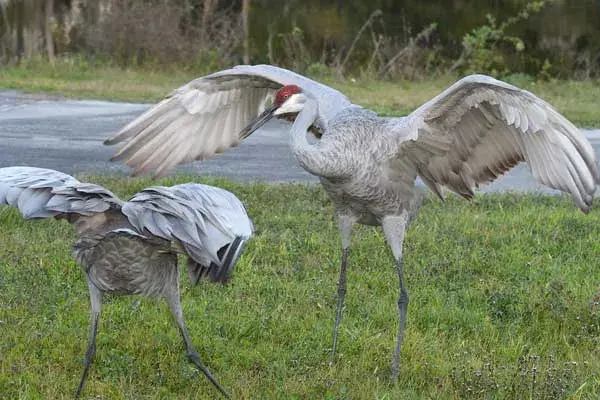
- Scientific Name: Grus canadensis
- Lifespan: 20 years
- Beak Length: 2.7-6.3 in
- Body Length: 47.2 in
- Range In Florida:
Sandhill cranes are very large, tall birds with long necks and legs, and very broad wings. They have mostly slate gray plumage, rusty washes on the upperparts, pale cheeks in adults, red head patches, and black legs.
Sandhill cranes have long, dark, and pointed beaks. Cranes might use them to stab predators; the beaks are powerful enough to pierce the skull of a small carnivore.
Florida is home to two subspecies of sandhill cranes: the Greater Sandhill Crane which migrates to Florida from the north and winters in Florida’s prairies and wetlands, and the Lesser Sandhill Crane, now known as the Florida Sandhill Crane, which is a year-round resident of the northeastern parts of the peninsula.
They are fairly social birds and can be usually found in pairs or family groups throughout the year.
Sandhill cranes are also monogamous and mate for life, staying together for years, until one of the cranes dies.
Their diet mostly consists of plant material, including waste grain, roots, berries, nuts, some insects, and snails.
American Flamingo

- Scientific Name: Phoenicopterus ruber
- Lifespan: 20-30 years
- Beak Length: n/a
- Body Length: 47-57 in
- Range In Florida: South Florida
American flamingos are giant pink birds with very long necks and legs. These wading birds are mainly pink with pink legs, red wing coverts, and black primary and secondary flight feathers.
American flamingos have large hooked pink and white beaks with black tips that are curved down. They feed with their beaks upside-down.
Special adaptations in the top half of their beaks allow them to filter food from the water.
American flamingos can be found in South Florida and the Florida Keys. The best time to see them there is from March to May, although some populations might stay in Florida Bay year-round.
Their call sounds like a goose honking.
American flamingos are also named “rosy flamingos” and get their color from the food they eat, shrimp, mollusks, and brine flies; these birds are omnivores and also consume some grass, seeds, and algae.
They will often wade through shallow waters, stirring up mud with their bills and feet and driving out the prey.
After becoming completely extirpated from Florida by the 1900s, these birds with long beaks have been reclaiming their lost range and increasing in numbers.
Read More: All pink-colored birds found in Florida
Whooping Crane
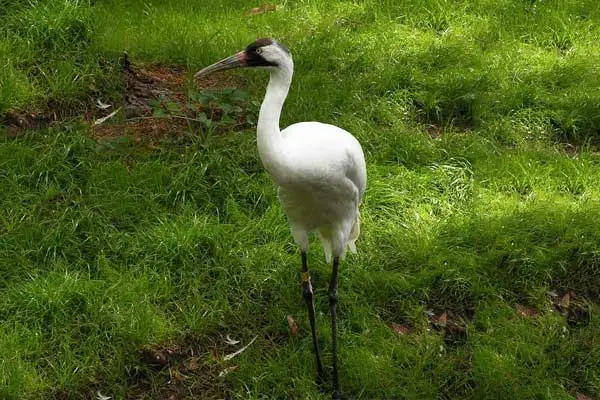
- Scientific Name: Grus americana
- Lifespan: 22-24 years
- Beak Length: 4.6-6.3 in
- Body Length: 52 in
- Range In Florida: Central Florida
Whooping cranes are the tallest birds in Florida. Together with sandhill cranes, they are the only two crane species native to North America and can range from 4 ft 1 inch to 5 ft 3 inches in height.
They have snowy white plumage, crimson caps, and black wings seen during flight.
Whooping cranes have very long, dark, and pointed beaks they use to probe the ground and hunt.
They can be seen year-round in central parts of Florida; around wetland areas, where they feed on crabs, clams, frogs, and aquatic plants.
Whooping cranes are known for their “unison calls” while courting and their loud bugle calls that last less than a second when they feel alarmed.
This endangered crane species had a population of around 20 birds in the 1940s. In recent years, thanks to strong conservation efforts, the total number of whooping cranes has now exceeded 800 birds.
In Central Florida, there is a non-migratory whooping crane population that the Florida Fish and Wildlife Conservation Commission (FWC) introduced in 1993.
They breed in the state between January and May, having a clutch size of one to three eggs. Both parents will incubate the eggs.
Whooping cranes have many predators, including black bears, wolves, foxes, coyotes, and eagles.
American White Ibis

- Scientific Name: Eudocimus albus
- Lifespan: 16 years in the wild
- Beak Length: 4.9-6.4 in
- Body Length: 21-28 in
- Range In Florida: Throughout Florida
American white ibises are wetland birds with overall white plumage and black wing tips seen during flight. They also have very long legs, pink facial skins, and long necks held straight in flight.
American white ibises have bright red-orange downcurved beaks that are longer in males. When the breeding season comes, their beaks become pink and tips become blackish.
These birds use them to probe the ground for food while foraging. They consume crabs, crayfish, fish, snakes, frogs, and insects.
White ibises are one of the most numerous wading birds in Florida and can be seen there throughout the year as they are permanent residents. Some colonies there can include over 30,000 birds.
American white ibises make several sounds, including the honking “urnk-urnk” call they use in flight or when agitated, and the muted “huu-huu” call when foraging.
They are mainly found around habitats like shallow coastal marshes, wetlands, and mangrove swamps. In Florida, they breed during spring and summer, females lay between two and four eggs, and both parents take turns in incubating the eggs.
White ibises are protected by the U.S. Migratory Bird Treaty Act.
Great Blue Heron

- Scientific Name: Ardea herodias
- Lifespan: 15 years
- Beak Length: 4.4-7 in
- Body Length: 36-54 in
- Range In Florida: Throughout Florida
Great blue herons are the largest North American herons and one of Florida’s largest birds.
They are blue-gray, have short black plumes on their heads, and black and chestnut patterns on the shoulders. During the flight, they will hold their necks in an S-shape with legs trailing behind.
Great blue herons have very long yellowish beaks that become orange at the start of the breeding season. Their sharp bills are from 4.4 to 7 inches long.
Great blue herons are permanent residents found in wetlands throughout Florida. In south Florida and the Florida Keys, there is an all-white subspecies of great blue herons known as the great white heron.
These birds native to Florida will go through some interesting courtship rituals, locking and rubbing their bills on the feathers of the other bird before mating.
Great blue herons are monogamous only for a single season and both parents will take turns in incubating the eggs.
They are carnivores that feed on fish, amphibians, reptiles, invertebrates, small mammals, and even other birds.
Great blue herons hunt by slowly stalking their prey in shallow waters, striking with lightning speed, and spearing it with their long and sharp beaks.
Scarlet Ibis
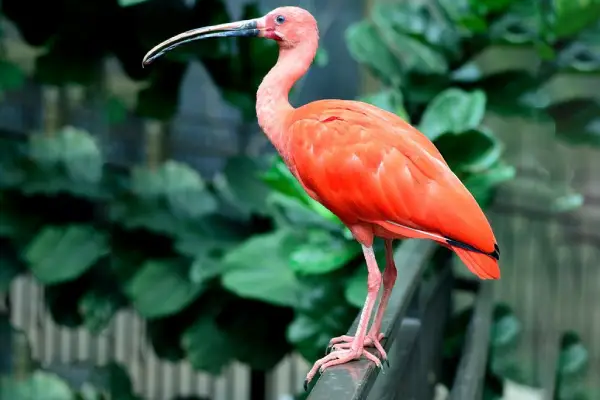
- Scientific Name: Eudocimus ruber
- Lifespan: 32 years
- Beak Length: 6-7 in
- Body Length: 22-25 in
- Range In Florida: Southern Florida
Scarlet ibises are large birds with long legs and necks and webbed feet. They are bright pink-red and have black wing tips.
Scarlet ibises are unmistakable due to their long, narrow, decurved beaks that are from 6-7 inches long. Their beaks can occasionally become black toward their tips.
Scarlet ibises were introduced to Florida and can now be seen year-round around marshes, swamps, inland wetlands, lawns, and shallow ponds of its southern parts.
These birds can be often spotted wading in shallow waters, probing mud and vegetation with their sensitive beaks in pursuit of food. They consume mollusks, crustaceans, fish, insects, frogs, and small snakes.
Despite spending most of their time wading and walking on the ground, scarlet ibises are great fliers, highly migratory, and can cross long distances. They can be spotted in groups of thirty and more, flying in a classic V formation.
Scarlet ibises are the national birds of Trinidad and Tobago.
Roseate Spoonbill

- Scientific Name: Platalea ajaja
- Lifespan: 10-15 years
- Beak Length: 6.4-8.1 in
- Body Length: 28-34 in
- Range In Florida: Southern Florida
Roseate spoonbills are unique-looking Florida birds. They are pink overall with white necks and featherless heads.
Roseate spoonbills have extremely long and wide spoon-shaped bills that are over 8 inches long. Their bills are gray and these enormous birds use them to stir the mud and catch prey.
Roseate spoonbills get their pink coloration from the pigments called carotenoids – crustaceans and other aquatic invertebrates spoonbills consume are full of those pigments and turn their feathers pink.
Roseate spoonbills can be seen throughout the year along the coastline of Southern Florida, from the southern islands of Florida Keys, Florida Bay, and Everglades, up to Tampa.
Look for groups of pink birds foraging in the shallows of fresh and saltwater, often with egrets and ibises nearby.
They are carnivores that eat crustaceans, aquatic insects, frogs, newts, and very small fish.
Roseate spoonbills breed in Southern Florida from November to December; in Central Florida, that happens around April. They will build their nests in dense mangroves or trees, and lay 2-5 whitish eggs with brown marks.
Similar to humans, these birds will lose feathers from the top of their heads as they get older.
Brown Pelican

- Scientific Name: Pelecanus occidentalis
- Lifespan: 20-40 years
- Beak Length: 11-13.7 in
- Body Length: 39-60 in
- Range In Florida: Coast of Florida
Brown pelicans are one of the most iconic sights on Florida shores; large, distinctive birds, silently gliding up or down the coastline with an occasional beat of their strong wings.
Brown pelicans are the second largest species of pelicans found in Florida. They have chestnut-and-white necks, white-colored heads with pale yellow crowns, brown-streaked backs, rumps, and tails, and black legs and feet.
Brown pelicans have oversized gray beaks, from 11 to 13.7 inches long. Under the beaks, there are large pouches of skin. During courtship, the beaks become red-orange and the pouches turn dark.
Pelicans use their pouches to catch fish and also to cool down, by evaporating water off the skin surface.
Brown pelicans can be seen just about everywhere along Florida’s coastline throughout the year.
This wasn’t always the case.
Until the 20th century, people were hunting brown pelicans heavily for their plumage. So in 1903, USA president Theodore Roosevelt established Pelican Island near Sebastian in Indian River County to protect the species.
In South Florida, nesting season begins in the fall; in central and northern Florida, it’s in early spring.
Brown pelicans are monogamous for a single season, and after mating, the pair will build their nest either on the ground or in trees. Males will bring the building material and the female will build the nest. Usually, a female will lay from one to four eggs per season.
Pelicans need to eat up to four pounds of fish (and perhaps some shrimp) per day to survive. They will even dive as deep as 30 feet to catch prey.
Read More: List of birds in Florida with orange beaks
American White Pelican
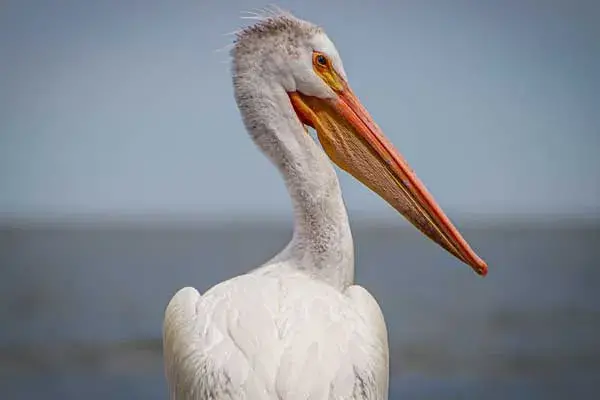
- Scientific Name: Pelecanus erythrorhynchos
- Lifespan: 16-30 years
- Beak Length: 10.3–15.2 in
- Body Length: 50-70 in
- Range In Florida: Throughout Florida
American white pelicans are the largest birds in Florida.
Everything about these all-white birds with black flight feathers is enormous. They have a wingspan of up to 9.85 feet and can weigh as much as 30 pounds.
American white pelicans also have the longest beaks of any North American waterbirds. Their beaks are vivid yellow-orange and measure 11.3–15.2 inches in males and 10.3–14.2 inches in females.
The beaks are flat on top and might have “horns” on the upper mandibles. Under the beaks, pelicans have huge throat sacs they use for feeding and filtering food from the water.
Unlike brown pelicans, which are year-round Florida residents, American white pelicans migrate to Florida to spend the winter there. They start arriving in the state around September and stay there until March; they move north to breed in the northern part of the Western USA and Canada.
Their diet mostly consists of fish, but also some crayfish and salamanders.
Read More: List of miniature white-colored birds common in FL
Summary
This concludes our list of Florida birds with long beaks.
Examples include several types of pelicans, hummingbirds, oystercatchers, gulls, herons, egrets, ibises, and spoonbills.
Next time, should you see these birds in person, you should be able to recognize any of them with ease!
And if you enjoyed our article, here are our other popular reads on birds: Examples of birds that have orange beaks and Examples of ducks that have blue beaks